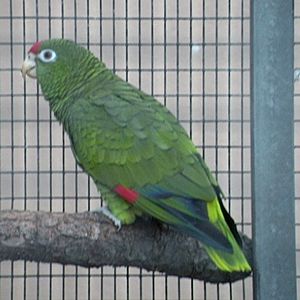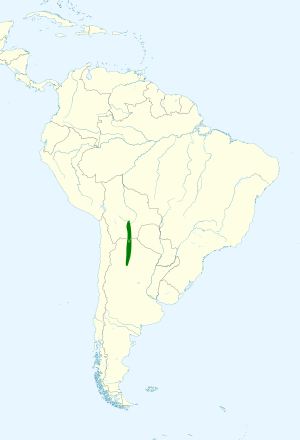Tucumán amazon facts for kids
Quick facts for kids Tucumán amazon |
|
|---|---|
 |
|
| At Loro Parque, Spain | |
| Conservation status | |
| Scientific classification | |
| Genus: |
Amazona
|
| Species: |
tucumana
|
 |
|
The Tucumán amazon is a special type of parrot. It's also called the Tucumán parrot or alder parrot. This beautiful bird lives in parts of Argentina and Bolivia. It is considered a vulnerable species, which means its population is getting smaller. It belongs to the family of parrots found in Africa and the New World.
Contents
About the Tucumán Amazon
The Tucumán amazon parrot is a unique bird. It is closely related to the red-spectacled amazon. Scientists now see them as "sister species," meaning they are very similar but distinct. The Tucumán amazon is a single species, with no different subspecies.
What Does the Tucumán Amazon Look Like?
This parrot is about 31 centimeters (12 inches) long. It usually weighs between 250 and 280 grams (about 9 to 10 ounces). Most of its body is green. Its feathers have black edges, which makes it look a bit scaly.
Colors and Markings
- Its forehead, and sometimes the area near its eyes, is red.
- It has white skin around its eyes.
- The lower part of its legs is orange-yellow.
- Some of its wing feathers are red.
- The feathers under its tail are yellow-green.
- The tips of its main wing feathers are blue.
- Its tail feathers have yellowish tips.
- Younger parrots have green legs.
Where the Tucumán Amazon Lives
The Tucumán amazon parrot lives in South America. You can find it in the Santa Cruz and Chuquisaca areas of Bolivia. It also lives south into Argentina, as far as Catamarca Province.
Habitat and Environment
This parrot prefers a special type of mountain forest called the Yungas. These forests have many alder trees (Alnus acuminata) or Podocarpus parlatorei trees. It mostly lives at high places, between 1,600 and 2,600 meters (about 5,200 to 8,500 feet) above sea level. Sometimes, it can be found as low as 500 meters (1,600 feet).
Tucumán Amazon Behavior
Seasonal Movements
The Tucumán amazon parrot moves with the seasons. It travels between higher mountain areas and lower places. From August to October, it can fly down to areas as low as 500 meters (1,600 feet). These lower areas are where the Gran Chaco and Yungas forests meet.
What the Tucumán Amazon Eats
These parrots have a varied diet. A study in Argentina showed that nearly a quarter of their food comes from the fruits and seeds of Podocarpus parlatorei trees. They also eat from at least six other types of plants. In winter, they mostly eat seeds from Acacia trees. They also enjoy flowers and fruits from both native and introduced plants.
Reproduction and Life Cycle
The Tucumán amazon parrot builds its nests between November and January. They make their homes in holes inside large trees. Often, these holes were made by woodpeckers. In one study in Argentina, parrots laid about 3 to 4 eggs on average, but some laid up to 5.
Nesting and Chicks
- The eggs hatch after 26 to 30 days.
- The young parrots leave the nest when they are 50 to 58 days old.
- Another study found that more nests were successful when there were plenty of Podocarpus parlatorei fruits available.
How the Tucumán Amazon Communicates
The Tucumán amazon parrot makes many different sounds. These include loud screeches and lower-pitched barks. When they fly, they make a repeated, high-pitched "quiowk" sound, which can sound a bit like a yelp.
Protecting the Tucumán Amazon
The Tucumán amazon parrot is currently listed as a "Vulnerable" species. This means its population is at risk. In 2004, it was thought to be of "Least Concern," but by 2011, its status changed to "Vulnerable."
Why the Population is Decreasing
- There are fewer than 15,000 adult parrots left.
- Their numbers are believed to be shrinking.
- A big problem is that people trap them to sell as pets. This is a main reason for their fast decline.
- Their natural home in Argentina is also being damaged and broken into small, separate areas.
Even though it lives in some protected areas, less than 25% of its favorite habitat is safe. It is common in some local spots but generally uncommon overall.
See also
 In Spanish: Loro alisero para niños
In Spanish: Loro alisero para niños


